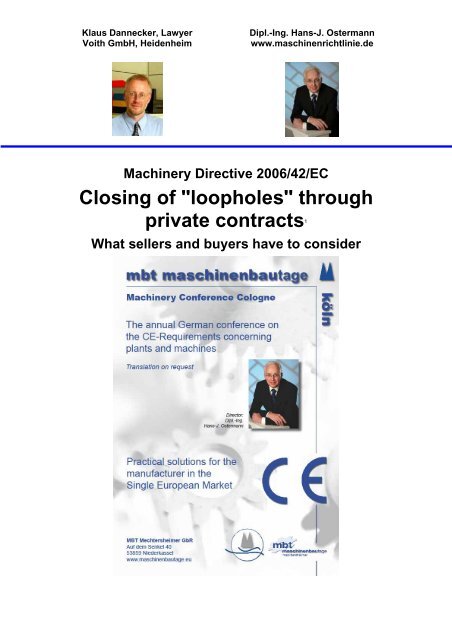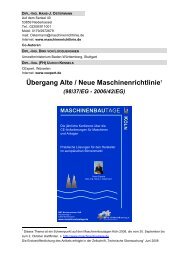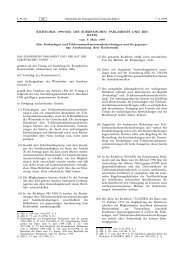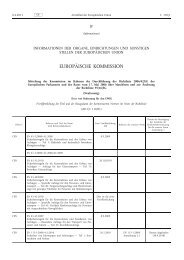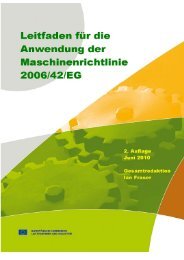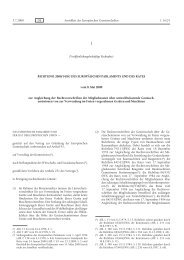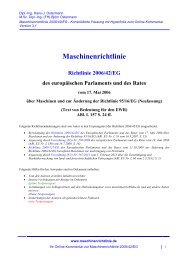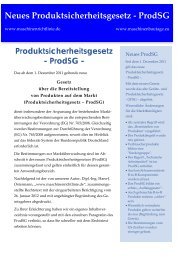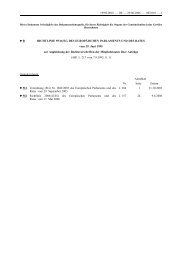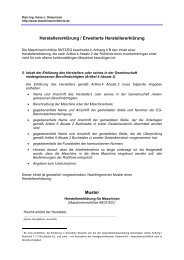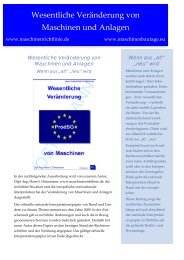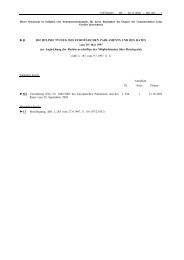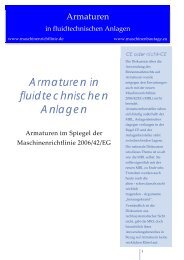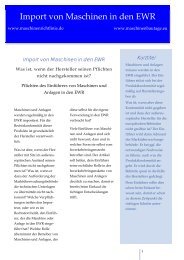Machinery Directive 2006/42/EC Closing of "loopholes" through ...
Machinery Directive 2006/42/EC Closing of "loopholes" through ...
Machinery Directive 2006/42/EC Closing of "loopholes" through ...
Create successful ePaper yourself
Turn your PDF publications into a flip-book with our unique Google optimized e-Paper software.
Klaus Dannecker, LawyerVoith GmbH, HeidenheimDipl.-Ing. Hans-J. Ostermannwww.maschinenrichtlinie.de<strong>Machinery</strong> <strong>Directive</strong> <strong>2006</strong>/<strong>42</strong>/<strong>EC</strong><strong>Closing</strong> <strong>of</strong> "loopholes" <strong>through</strong>private contracts 1What sellers and buyers have to consider
Dannecker / Ostermann: Loopholes in the <strong>Machinery</strong> <strong>Directive</strong> <strong>2006</strong>/<strong>42</strong>/<strong>EC</strong>ContentsIntroduction…………………………………………………………………… 3Demands on the manufacturer………………………………… 3Who is actually the "manufacturer"?................................ 4What has actually to be supplied?....................................... 7When does the conformity documentation have tobe handed over?.................................................................................. 8Points <strong>of</strong> particular note for partly completedmachinery.................................................................................................. 9The assessment <strong>of</strong> the contract conformity <strong>of</strong> thesupply........................................................................................................... 11Conclusion……………………………………………………………….…... 111 First publication "Technical Safety" Springer VDI-Verlag, March 20112
Dannecker / Ostermann: Loopholes in the <strong>Machinery</strong> <strong>Directive</strong> <strong>2006</strong>/<strong>42</strong>/<strong>EC</strong>IntroductionAfter more than 15 years, the EuropeanUnion has decided on a comprehensiveamendment <strong>of</strong> the European <strong>Machinery</strong><strong>Directive</strong>. As <strong>of</strong> 29.12.2009, the new<strong>Machinery</strong> <strong>Directive</strong> <strong>2006</strong>/<strong>42</strong>/<strong>EC</strong> 2 wasimplemented in binding German nationallaw. Corresponding nationalimplementations were enacted at thesame time also in all other member states<strong>of</strong> the EEA as well as in Switzerland andTurkey. 3While earlier demarcation problemsbetween the <strong>Machinery</strong> <strong>Directive</strong> and theLow Voltage <strong>Directive</strong> were reduced andmore legal security was gained by theinclusion <strong>of</strong> "partly completed machinery"in the list <strong>of</strong> products covered by the scope<strong>of</strong> the <strong>Machinery</strong> <strong>Directive</strong>, a lack <strong>of</strong> clarityand points <strong>of</strong> uncertainty can still beobserved in practice even one year afterthe new <strong>Machinery</strong> <strong>Directive</strong> came int<strong>of</strong>orce when it comes to the implementation<strong>of</strong> the demands <strong>of</strong> the <strong>Machinery</strong> <strong>Directive</strong>in the procurement process betweensellers <strong>of</strong> machinery on the one hand andthe buyers <strong>of</strong> machinery on the other, asthe following examples from a quotationfrom a machine manufacturer show:contract parties tips for the drafting <strong>of</strong>contracts with respect to the handling <strong>of</strong>the subjects governed by and thedemands <strong>of</strong> the <strong>Machinery</strong> <strong>Directive</strong>.Demands on the manufacturerAccording to Article 5 <strong>of</strong> the <strong>Machinery</strong><strong>Directive</strong>, the manufacturer <strong>of</strong> machinery /partly completed machinery must satisfythe following demands: The machine must satisfy therequirements <strong>of</strong> Annex I <strong>of</strong> the<strong>Machinery</strong> <strong>Directive</strong> "A CE mark on the machines suppliedby us is not generally covered by thecontract. Should you wish for such amark, this shall require our expresswritten confirmation." "A precondition for the supply inexceptional cases <strong>of</strong> a product notconforming to the <strong>EC</strong> directives is thesigning <strong>of</strong> an "indemnificationdeclaration" with the followingcontent ..."With this paper the authors aim to trackdown public law loopholes in the scope <strong>of</strong>the <strong>Machinery</strong> <strong>Directive</strong> and to give the2 DIR<strong>EC</strong>TIVE <strong>2006</strong>/<strong>42</strong>/<strong>EC</strong> OF THE EUROPEANPARLIAMENT AND OF THE COUNCIL <strong>of</strong> 17 May<strong>2006</strong> on machinery. The <strong>Machinery</strong> <strong>Directive</strong> thathas been amended several times in the meantime isavailable in a consolidated version at"www.maschinenrichtlinie.de" (German text only)3 See www.maschinenrichtlinie.de under"Geltungsbereich" The drawing up <strong>of</strong> a risk assessment ismandatory The technical file on the machinerymust be available The operating instructions (or assemblyinstructions in the case <strong>of</strong> partlycompleted machinery) must accompanythe machinery The corresponding conformity assessmentprocedure (or special procedures3
Dannecker / Ostermann: Loopholes in the <strong>Machinery</strong> <strong>Directive</strong> <strong>2006</strong>/<strong>42</strong>/<strong>EC</strong>in the case <strong>of</strong> partly completedmachinery) must have been performed The <strong>EC</strong> Declaration <strong>of</strong> Conformity ordeclaration <strong>of</strong> incorporation must becompleted and must accompany themachinery The CE mark expressing the conformity<strong>of</strong> the machinery with all the relevant<strong>EC</strong> <strong>Directive</strong>s demanding such amarking must be attached to themachineNote:Partly completed machinery, bycontrast, does not bear a CE markunless another <strong>EC</strong> single marketdirective applicable to the partlycompleted machinery demands such amark The manufacturer <strong>of</strong> machinery musthave the necessary means tomanufacture the machinery "safely"Note:"<strong>Machinery</strong>" in the above sense is used forthe sake <strong>of</strong> simplicity as a generic term forall products in the sense <strong>of</strong> Article 2 a) to f)<strong>of</strong> the <strong>Machinery</strong> <strong>Directive</strong>, while the term"partly completed machinery" in the sense<strong>of</strong> Article 2 g) <strong>of</strong> the <strong>Machinery</strong> <strong>Directive</strong> isused separately, see also the correspondingprovisions in Article 2 <strong>of</strong> the<strong>Machinery</strong> <strong>Directive</strong>.Compliance with these requirements is amandatory precondition for the placing <strong>of</strong>machinery (or partly completed machinery)on the market. Failure to comply with thepreconditions can result in stringent measuresbeing taken by the responsibleauthorities in accordance with § 8 (4)GPSG; these cannot, however, becovered in more detail in this paper.In practical application it has beenobserved, however, that the <strong>Machinery</strong><strong>Directive</strong> leaves considerable scope forinterpretation in some area and has loopholesthat lead to legal uncertainty in thedrafting <strong>of</strong> contracts. This paper aims togive examples as to how these loopholescan be expediently closed within thecontext <strong>of</strong> the contract drafting.Who is actually the "manufacturer"?The manufacturer or his authorisedrepresentative is responsible for thecompliance with the fundamental healthyand safety requirements <strong>of</strong> Annex I <strong>of</strong> the<strong>Machinery</strong> <strong>Directive</strong> and for the performance<strong>of</strong> the above measures forestablishment / declaration <strong>of</strong> the "<strong>EC</strong>conformity" <strong>of</strong> the machinery. The manufactureror his authorised representative isalso the primary addressee <strong>of</strong> measurestaken by the responsible authorities.Against this background, the question <strong>of</strong>who the manufacturer <strong>of</strong> the machinery isin individual cases is <strong>of</strong> great relevance.While "single source" machinery (in thesense <strong>of</strong> the design and manufacture <strong>of</strong>the machinery) generally does not pose aproblem (even in the light <strong>of</strong> the fact thatthe property <strong>of</strong> "manufacturer" is not lostby the sub-contracting <strong>of</strong> work) 4 , a lack <strong>of</strong>clarity as to the person <strong>of</strong> the manufacturercan quite conceivably arise in certaincases with "machine plants" (assemblies<strong>of</strong> machinery in the sense <strong>of</strong> Article 2 a)4th indent <strong>of</strong> the <strong>Machinery</strong> <strong>Directive</strong>).If we look at the definition <strong>of</strong> the manufactureras defined in Article 2 i) <strong>of</strong> the<strong>Machinery</strong> <strong>Directive</strong> more closely"... any natural or legal person whodesigns and/or manufactures machineryor partly completed machinery coveredby this <strong>Directive</strong> and is responsible forthe conformity <strong>of</strong> the machinery or thepartly completed machinery with this<strong>Directive</strong> with a view to its being placedon the market, under his own name ortrademark or for his own use,"then a broad scope for interpretationbecomes obvious, particularly forengineering “assemblies <strong>of</strong> machinery” 5(machinery plants). The manufacturer canthen be:4 cf. clause 3.1.1 <strong>of</strong> the European Commission's"Guide to the Implementation <strong>of</strong> <strong>Directive</strong>s Basedon the New Approach" - Blue Guidehttp://www.maschinenrichtlinie.de/fileadmin/dokumente/Binnenmarktleitfaden%20Blueguide.pdf5 See <strong>Machinery</strong> <strong>Directive</strong>, Article 2, paragraph a,fourth indent4
Dannecker / Ostermann: Loopholes in the <strong>Machinery</strong> <strong>Directive</strong> <strong>2006</strong>/<strong>42</strong>/<strong>EC</strong> The plant design engineer The plant construction engineer The person who attaches his name / histrademark to the plant The "in-house manufacturer" whomanufactures the plant for his own useHow can this "dilemma" be resolved?For the question as to who themanufacturer is, the definition <strong>of</strong> the"manufacturer" in the <strong>Machinery</strong> <strong>Directive</strong>essentially focuses on the question as towho bears the "overall responsibility" forthe safety <strong>of</strong> the machine plant:"[The person who] is responsible for theconformity <strong>of</strong> the machinery … with thisdirective with a view to its being placedon the market …."This is also made clear in the Blue Guide 6in section 3.1.1:6http://www.maschinenrichtlinie.de/fileadmin/dokumente/Binnenmarktleitfaden%20Blueguide.pdf„A manufacturer, in the meaning <strong>of</strong> NewApproach, is the person who isresponsible for designing andmanufacturing a product"At first sight there is a great deal here tosuggest that the "main supplier" (= thesupplier <strong>of</strong> the main components <strong>of</strong> theplant) is the plant manufacturer. This is notnecessarily the case, however. It can justas easily be e.g. the engineering <strong>of</strong>ficeresponsible for the plant conformity,particularly if it carries out the detailengineering or safety engineering.Also conceivable, however, is the erectioncompany that assembles all the plantcomponents "safely" or the control systeminstaller who integrates the plantcomponents into his control system. Inmany cases the plant operator has alsoappointed a project manager who "keepshold <strong>of</strong> the reins" so that the plant owneras an "in-house manufacturer" can also beconsidered for the declaration <strong>of</strong>conformity <strong>of</strong> the plant as a whole, as heholds the "project or planning sovereignty"with respect to the plant.5
Dannecker / Ostermann: Loopholes in the <strong>Machinery</strong> <strong>Directive</strong> <strong>2006</strong>/<strong>42</strong>/<strong>EC</strong>Of relevance to the decision, and hence aquestion also to be clarified, is who caninfluence the safety engineering propertiesduring design and construction <strong>of</strong> the plantup to its placement on the market orputting into service.In order to avoid discussions and highcosts later, the parties involved in a plantproject are therefore well advised to giveconsideration to the question <strong>of</strong> the overallIf it is not clear who the plant manufactureris, then it is also not clear who isresponsible for drawing up the riskassessment for the plant so that inpractice this is – legally inadmissibly –frequently not carried out. Added to that isthe fact that safety engineering correctionsdue to a delay in drawing up the riskassessment generally entail high costs.With the right approach, these costs- caused by a wrong engineeringresponsibility at the time <strong>of</strong> conclusion <strong>of</strong>the contract. A later clarification after thestart <strong>of</strong> the planning or engineeringinvolves great expense and is furthermorelegally inadmissible (cf. Annex I <strong>Machinery</strong><strong>Directive</strong>: „The machinery must then bedesigned and constructed taking intoaccount the results <strong>of</strong> the riskassessment").approach - can be avoided.Agreement on the person <strong>of</strong> the plantmanufacturer in the contracts between theparticipating parties is therefore urgentlyrecommended. Agreement could bereached, for example, on the followingcontract clause in the relationshipbetween main supplier and plant owner:6
Dannecker / Ostermann: Loopholes in the <strong>Machinery</strong> <strong>Directive</strong> <strong>2006</strong>/<strong>42</strong>/<strong>EC</strong>The contract parties are agreed that[name <strong>of</strong> the company] is manufacturer <strong>of</strong>the complete plant in the sense <strong>of</strong> Article2 lit. i <strong>of</strong> the <strong>Machinery</strong> <strong>Directive</strong><strong>2006</strong>/<strong>42</strong>/<strong>EC</strong> and assumes the duties <strong>of</strong>the manufacturer defined in Article 5clause 1 <strong>of</strong> this <strong>Directive</strong> for the completeplant to be placed onto the market." 7Where necessary, contractual cooperationobligations <strong>of</strong> the other contract partyshould also be defined. If, for example, themain supplier is the manufacturer <strong>of</strong> theplant and the plant owner purchases parts<strong>of</strong> the plant himself, the relationshipbetween manufacturer and plant owner'ssub-supplier must also be clarified. Themain supplier must, for example, be giventhe possibility by the plant owner in hiscontracts with his suppliers to consultthese suppliers and, where necessary, toexamine the conformity documentation asthe main supplier has no contractualrelationship with the plant owner'ssuppliers.What has actually to be supplied?The machinery manufacturer's public lawscope <strong>of</strong> supply is described in Article 5 <strong>of</strong>the <strong>Machinery</strong> <strong>Directive</strong>.It states that together with the machinery,the following must be handed over to thebuyer:The <strong>EC</strong> Declaration <strong>of</strong> Conformity inaccordance with Annex II part 1Section A The necessary information (Annex I,No. 1.7 <strong>Machinery</strong> <strong>Directive</strong>), such asthe operating instructions (Annex I, No.1.7.4 <strong>Machinery</strong> <strong>Directive</strong>)In addition, the technical file must beavailable for examination / inspection bythe responsible market supervisoryauthorities (Article 5(1) b in conjunctionwith Annex VII part A No. 2 <strong>Machinery</strong><strong>Directive</strong>).7 See www.maschinenrichtlinie.de on the subject"Responsible persons / plant manufacturer"7
Dannecker / Ostermann: Loopholes in the <strong>Machinery</strong> <strong>Directive</strong> <strong>2006</strong>/<strong>42</strong>/<strong>EC</strong>What does this mean with respect to therisk assessment?Under public law the buyer <strong>of</strong> machinery(including machine plants) / partlycompleted machinery has no right todemand the handover <strong>of</strong> the seller's riskassessment. It is intended as part <strong>of</strong> thetechnical file only for examination by theauthorities.In individual cases, e.g. with complexplants where the plant owner as "in-housemanufacturer" has to evaluate theCE conformity <strong>of</strong> given interfaces or insituations where existing plants aremodified, however, it is quiteunderstandable that the buyer demandsthe handover <strong>of</strong> the risk assessment <strong>of</strong>machinery / partly completed machinery.This can only be agreed upon by privatelaw within the scope <strong>of</strong> the supplycontract. In view <strong>of</strong> the private autonomy,the contract parties have the possibility todefine the subject <strong>of</strong> supplies andservices.Example <strong>of</strong> a contract clause:"The documents to be handed over by theSeller shall also include the riskassessment in accordance with theGeneral Principles <strong>of</strong> Annex I <strong>of</strong> the<strong>Machinery</strong> <strong>Directive</strong> <strong>2006</strong>/<strong>42</strong>/<strong>EC</strong> for themachinery / partly completed machinery tobe supplied."Without such an "agreement on condition",however, the buyer has no entitlement toclaim the handover <strong>of</strong> the risk assessment.Alternatively it can be agreed, for example,that the machinery owner / buyer canexamine the manufacturer's / seller's riskassessment at his company premisesinstead <strong>of</strong> the handover. In both casesagreement on an obligation to confidentialhandling <strong>of</strong> the manufacturer's technicalsolutions is justified, as it isunquestionable that this constitutes knowhow<strong>of</strong> the manufacturer / seller that is notyet in the public domain and is thereforeworthy <strong>of</strong> protection.When does the conformity documentationhave to be handed over?The <strong>Machinery</strong> <strong>Directive</strong> prescribes inArticle 5 (1) that the <strong>EC</strong> declaration <strong>of</strong>conformity must be handed over to theowner / user together with the machinerywhen it is placed on the market or put intoservice. While the time <strong>of</strong> placement ontothe market or putting into service <strong>of</strong>individual machines generally raises noquestions, this is <strong>of</strong>ten seen as a complexprocess <strong>of</strong> long duration in the case <strong>of</strong>machine plants, as the "trial operation" bythe plant manufacturer is regularly carriedout after the end <strong>of</strong> the erection work, i.e.the machine plant is adjusted, run in, etc.The trial operation by the plantmanufacturer is, however, regularlycharacterised in that the machine plantdoes not yet satisfy the demands <strong>of</strong> the<strong>Machinery</strong> <strong>Directive</strong> in all respects, inparticular Annex I, as e.g. guards have notyet been fitted, covers have to be removedagain, etc. An issue <strong>of</strong> the <strong>EC</strong> declaration<strong>of</strong> conformity and the attachment <strong>of</strong> theCE marking is not yet admissible at thispoint, so that this does not represent a"placement on the market". This trialoperation consequently takes place on amachine plant that is still in themanufacturing phase. The trial operationat this time is therefore subject to theoccupational safety provisions under theresponsibility <strong>of</strong> the plant manufacturer.The machine plant must satisfy theprotection goals <strong>of</strong> Annex I <strong>Machinery</strong><strong>Directive</strong> only at the time <strong>of</strong> placement onthe market or <strong>of</strong> putting into service. Likewith a single machine this is a "point intime" and not a "period <strong>of</strong> time.There is therefore a need for clarification<strong>of</strong> the "safety-related", i.e. the point atwhich the plant manufacturer's trialoperation has been concluded, themachine plant satisfies the public lawrequirements such as the <strong>Machinery</strong><strong>Directive</strong> and the machine plant can beplaced on the market or put into service.Private law measures can be taken here,e.g. in the form <strong>of</strong> a commissioningprotocol to be signed by both contractparties in which the owner / buyer not onlyconfirms that e.g. the mechanical function8
Dannecker / Ostermann: Loopholes in the <strong>Machinery</strong> <strong>Directive</strong> <strong>2006</strong>/<strong>42</strong>/<strong>EC</strong><strong>of</strong> the machine plant is assured or e.g. theproduction over a 24-hour period <strong>of</strong>operation has been successfullydemonstrated, but also that the machineplant satisfies the public law requirements<strong>of</strong> the <strong>Machinery</strong> <strong>Directive</strong> ("CEacceptance"). From this point in time, theowner / buyer is responsible in accordancewith Article 4(2) <strong>of</strong> the <strong>Directive</strong>2009/104/<strong>EC</strong> for ensuring that this safetylevel is not infringed during the furtheroperation <strong>of</strong> the machine plant.Example <strong>of</strong> a contract clause in thecommissioning protocol:"With the commissioning <strong>of</strong> the subject <strong>of</strong>supply, it shall be placed at the Buyer'sdisposal for the first time for its intendeduse. The Buyer confirms that at this timethe subject <strong>of</strong> supply satisfies the safetyand health protection requirements <strong>of</strong> the<strong>Machinery</strong> <strong>Directive</strong> <strong>2006</strong>/<strong>42</strong>/<strong>EC</strong> and <strong>of</strong>the other relevant European directives <strong>of</strong>the Community and therefore functionsand can be operated safely."This does not preclude the necessity forfurther contractual provisions, e.g. on thequality <strong>of</strong> the machine plant over andabove this "safety-related transfer <strong>of</strong>perils". The "CE acceptance" musttherefore not necessarily constitute a"quality acceptance" at the same time.This can and will as a rule take place later,e.g. when the product-specificperformance values <strong>of</strong> the machine planthave been demonstrated, e.g. in the form<strong>of</strong> test or guarantee runs. The advantage<strong>of</strong> such a split acceptance is that after the"CE acceptance", the owner can producewith the plant from a public law point <strong>of</strong>view because it is "safe".Points <strong>of</strong> particular note for partlycompleted machinery1. Declaration <strong>of</strong> incorporation instead <strong>of</strong><strong>EC</strong> declaration <strong>of</strong> conformitySince 29.12.2009, certain manufacturer'sobligations in accordance with Article 5 (2)and Article 13 <strong>Machinery</strong> <strong>Directive</strong> applyalso to "partly completed machinery" asdefined in Article 2 g) <strong>Machinery</strong> <strong>Directive</strong>.In particular a special procedure (not aconformity assessment procedure) inaccordance with Article 13 in conjunctionwith Annex VII B <strong>Machinery</strong> <strong>Directive</strong> hasto be carried out which includes also thedrawing up <strong>of</strong> a risk assessment. Thedeclaration <strong>of</strong> incorporation in accordancewith Annex II Part 1 Section B <strong>Machinery</strong><strong>Directive</strong> to be drawn up and handed overto the buyer, however, requires themanufacturer only to indicate whichfundamental requirements <strong>of</strong> the<strong>Machinery</strong> <strong>Directive</strong> in the sense <strong>of</strong> theprotective goals <strong>of</strong> Annex I <strong>Machinery</strong><strong>Directive</strong> are applied and fulfilled. Themanufacturer <strong>of</strong> the partly completedmachinery can therefore limit himself inthe declaration <strong>of</strong> incorporation toindividual safety and health protectionrequirements which in his view areapplicable to the partly completedmachinery.For the buyer, however, who integratesthe partly completed machinery into acomplete machine, or assembles ittogether with other machinery or partlycompleted machinery, it is <strong>of</strong>ten importantthat the manufacturer <strong>of</strong> the partlycompleted machinery confirms that thisconforms to all the safety and healthprotection requirements in the sense <strong>of</strong>Annex I <strong>Machinery</strong> <strong>Directive</strong> relevant andapplicable to the partly completedmachinery up to the interfaces indicated inthe documentation.This can be achieved in that themanufacturer <strong>of</strong> the partly completedmachinery undertakes contractually toissue an "extended declaration <strong>of</strong>incorporation" 8 in which he certifiesprecisely this statement.In this way the buyer who installs thispartly completed machinery in the finalmachine / plant receives a high degree <strong>of</strong>legal security.8 See www.maschinenrichtlinie.de “ErweiterteEinbauerklärung”9
Dannecker / Ostermann: Loopholes in the <strong>Machinery</strong> <strong>Directive</strong> <strong>2006</strong>/<strong>42</strong>/<strong>EC</strong>2. Assembly instructions instead <strong>of</strong>operating instructionsAccording to the procedure for partlycompleted machinery described inArticle 13 <strong>Machinery</strong> <strong>Directive</strong>, themanufacturer must ensure that assemblyinstructions in accordance withAnnex VI <strong>Machinery</strong> <strong>Directive</strong> are drawnup and that these are included with thepartly completed machinery. According toAnnex VI <strong>Machinery</strong> <strong>Directive</strong>, theassembly instructions for partly completedmachinery must contain a description <strong>of</strong>the conditions which must be met with aview to correct incorporation <strong>of</strong> the partlycompleted machinery into the finalmachinery, so as not to compromisesafety and health <strong>of</strong> persons.These are therefore installation orassembly instructions for the owner/buyer.The question must be permitted at thispoint as to where the stipulations for theintended use <strong>of</strong> the partly completedmachinery (this is by no means exhaustedby the simple installation in final machinery,as the partly completed machineryalso has to fulfil certain functions) or eventhe reasonably foreseeable misuse <strong>of</strong> thepartly completed machinery are contained,and in particular what risks exist during theuse <strong>of</strong> the partly completed machinery- after installation - and how users canprotect themselves against these risks.Strictly speaking, this information does notform part <strong>of</strong> the assembly instructions. Thebuyer is therefore neither informed aboutthe intended use <strong>of</strong> the partly completedmachinery, nor does he receiveinformation on (residual) risks which canarise during such an intended use orreasonably foreseeable misuse <strong>of</strong> thepartly completed machinery. Theconclusions drawn by the EU Commissionon the stipulations in the assemblyinstructions in § 390 <strong>of</strong> the EU Guide tothe <strong>Machinery</strong> <strong>Directive</strong> 9 therefore go to<strong>of</strong>ar, even if this would be desirable for thepractical application.9 Guide to Application <strong>of</strong> the <strong>Machinery</strong> <strong>Directive</strong><strong>2006</strong>/<strong>42</strong>/<strong>EC</strong>, 2 nd Edition June 201010
Dannecker / Ostermann: Loopholes in the <strong>Machinery</strong> <strong>Directive</strong> <strong>2006</strong>/<strong>42</strong>/<strong>EC</strong>But the manufacturer <strong>of</strong> the partlycompleted machinery exposes himself toproduct liability law risks if he limits thedocumentation to be supplied with thepartly completed machinery to therequirements <strong>of</strong> Annex VI <strong>Machinery</strong><strong>Directive</strong>. Both the manufacturer liabilityunder tort law in accordance with § 823 (1)German Civil Code (BGB), and the liability<strong>of</strong> the manufacturer under the GermanProduct Liability Act (§ 3 (1) lit. a) ProdHGwhich is based on the Council <strong>Directive</strong>85/374/E<strong>EC</strong>) sanction faulty or the lack <strong>of</strong>operating instructions or instructions foruse and / or a lack <strong>of</strong> warnings againstpotentially hazardous properties <strong>of</strong> aproduct (keyword: "faulty instruction") 10 .The contract parties to the purchase <strong>of</strong>partly completed machinery are thereforewell advised to also include the point"operating instructions" in their contractdocuments. See also the "extendeddeclaration <strong>of</strong> incorporation" mentionedabove.The assessment <strong>of</strong> the contractconformity <strong>of</strong> the supplyWe should expressly point out once againhere:The CE marking on machinery / plantsmakes no statement about the (agreed)quality <strong>of</strong> a product. The CE marking hasto fulfil a different function, namely that <strong>of</strong>assuring the freedom <strong>of</strong> the movement <strong>of</strong>goods within the European single market.Thus it is like an “European-single-marketpassport”for goods and not a qualitysymbol with respect to safety.The assessment <strong>of</strong> the agreed condition /quality <strong>of</strong> a product, and hence thecontract conformity <strong>of</strong> the supply, isperformed purely under private law. If thepurchase is e.g. a commercial transactionfor both parties, the buyer must ensure inaccordance with § 377 GermanCommercial Code (HGB) that the goodsare examined for visible defectsimmediately on arrival in his "domain", and10 See www.maschinenrichtlinie.de under theheading "Produkthaftung” (Product liability)that notice <strong>of</strong> any defects discovered isgiven immediately.Failure to meet this obligation regularlyresults in the loss <strong>of</strong> the rights with respectto material defects, at least as far as thedefects not discovered or not reported areconcerned (the question as to what extentthe buyer can assign this obligation to theseller is not the subject <strong>of</strong> this paper).In the case <strong>of</strong> contracts for work (which isregularly the case for contracts for theconstruction <strong>of</strong> a complex machinery planttailored individually to the needs <strong>of</strong> theowner / buyer), the ordering party has toaccept the work manufactured by thecontractor:(§ 640 BGB)"Acceptance" means here the receipt <strong>of</strong>the manufactured work and itsrecognition as being in conformity withthe contract.In the case <strong>of</strong> contracts for the purchase <strong>of</strong>(individual) machine or partly completedmachinery, however, it is recommendedthat tests for the pro<strong>of</strong> <strong>of</strong> the agreedquality are also agreed. This can beachieved contractually <strong>through</strong> the termsfor the acceptance <strong>of</strong> the goods / services.In the case <strong>of</strong> long-term supplyrelationships it is recommended – also inthe light <strong>of</strong> minimising the product liabilityrisks – that "quality assuranceagreements" are concluded.A quality assurance agreement is to beunderstood as quality assurancemeasures contractually agreed with asupplier in which i.a. the following pointscan be defined in concrete terms: Quality goals for the individual parts /components Pro<strong>of</strong> <strong>of</strong> quality by the supplier, such ase.g. quality control measures to beperformed, presentation <strong>of</strong> testcertificates, etc. Quality assurance Exchange <strong>of</strong> quality data Demands on the supplier's qualitymanagement systems11


